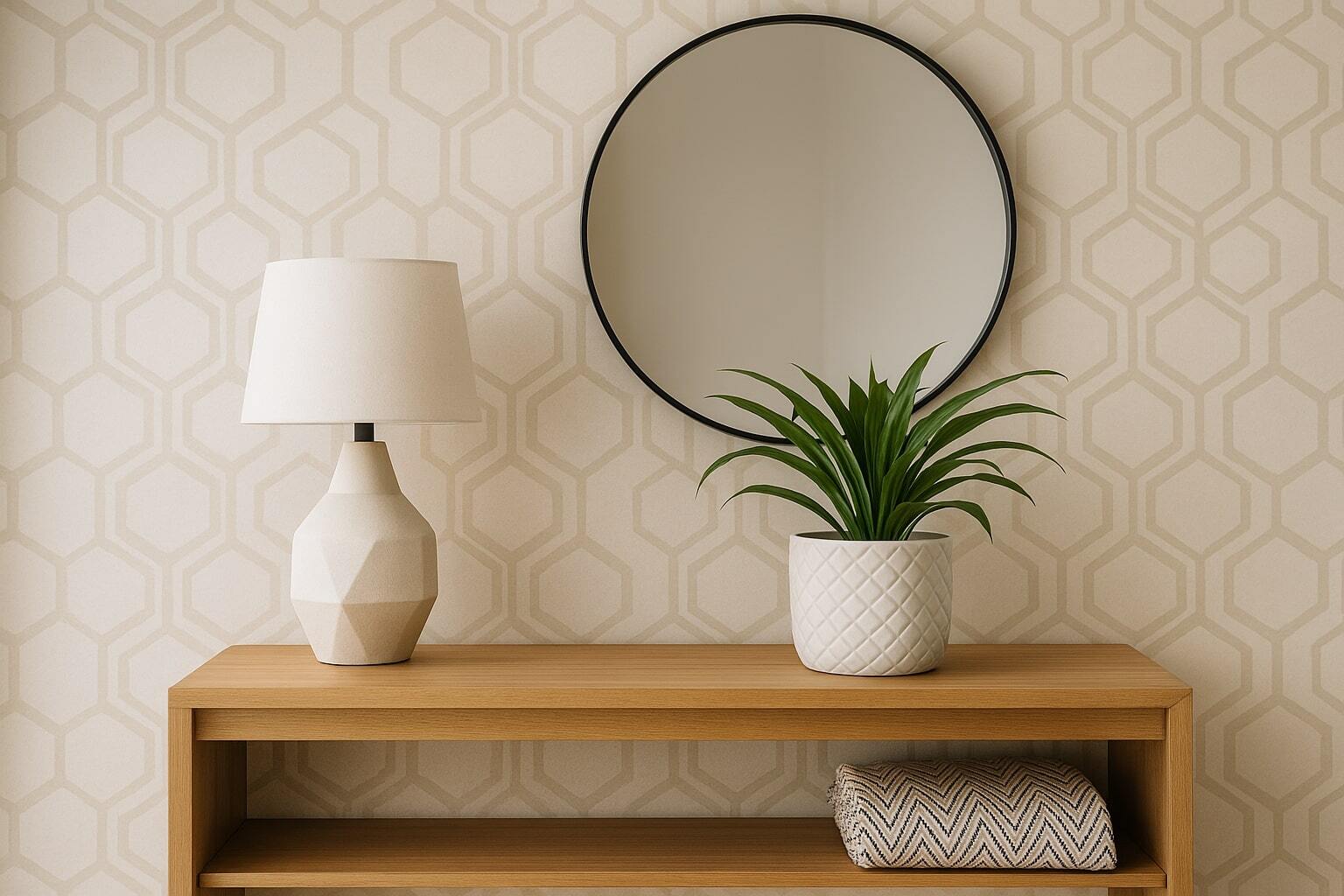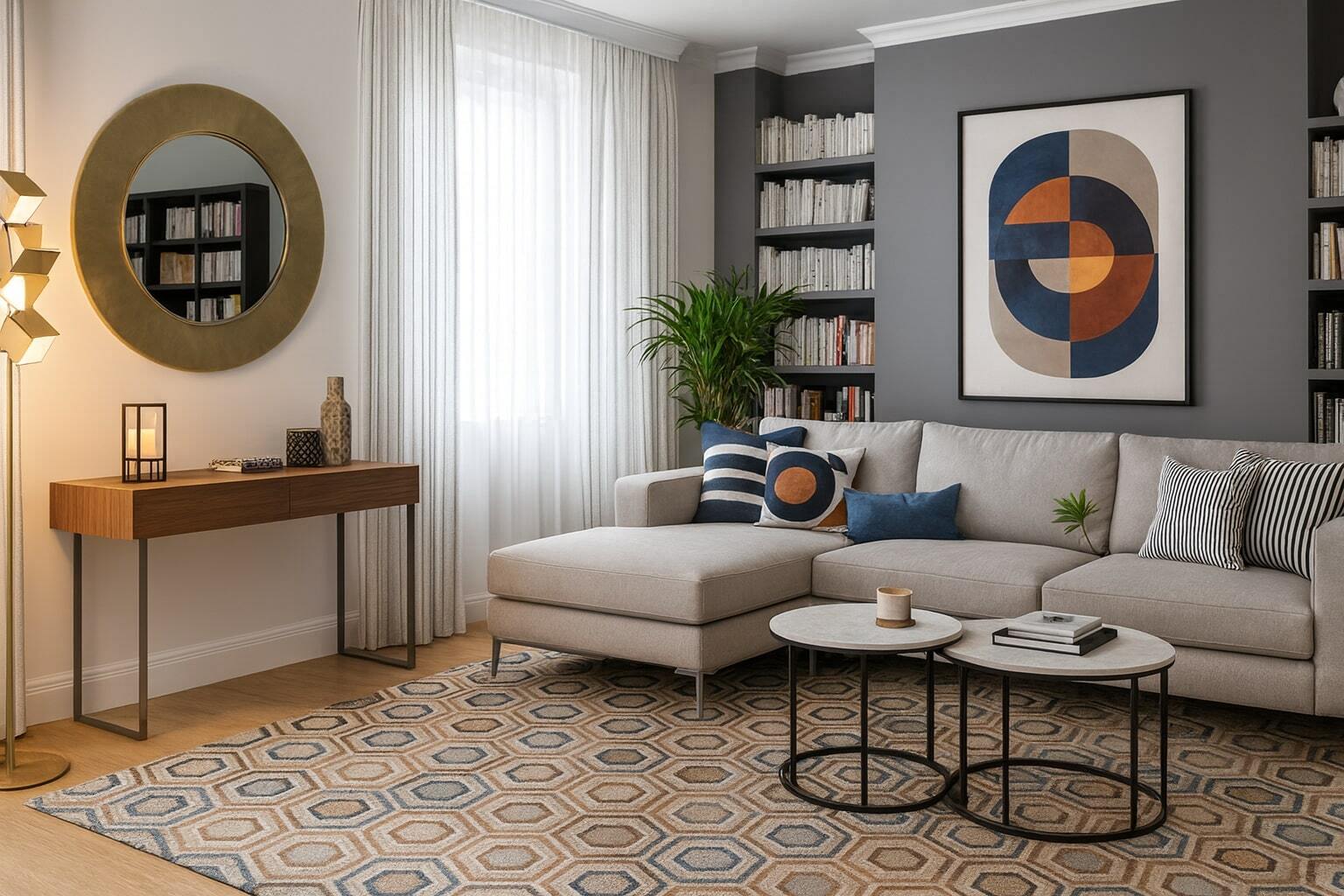Geometry in Interior Design: Shapes, Style & 2026 Trends
Posted by Jason Wyrwicz on Nov 29th 2025

Geometry has always played a quiet but powerful role in interior design. The shapes, lines, and angles within a room influence how we feel in a space, whether it feels open or cosy, calm or energetic, minimal or expressive. When used intentionally, geometric forms can reshape a room’s visual rhythm, guide the eye, and even change how large or balanced a space appears.
Put simply, geometric interior design is the practice of using deliberate shapes, lines, patterns, and forms, from circles and triangles to hexagons and bold graphic motifs, to structure a space and create visual interest. When done well, it offers a blend of modern precision and artistic personality that can transform any room.
In this guide, you will learn how to work with geometric shapes and patterns in everyday interiors, including where they work best, how designers apply them, the biggest geometry-driven trends for 2025 and 2026, and the common mistakes to avoid. You will also get practical tips on how to incorporate geometric elements into your own home, no matter your existing style or budget.
What Is Geometric Interior Design?
Geometric interior design is the intentional use of lines, shapes, angles, and patterned forms to organise a space and add visual interest. It draws on the essential principles of shape in interior design, using circles, squares, triangles, and other geometric shapes to build structure and rhythm.
These features appear in many examples of shape in interior design, such as the silhouette of furniture, the layout of tiles, and the patterns found in textiles and wall décor.
This style has become especially relevant in modern homes, where clean layouts allow bold geometry to stand out. Designers often combine minimal aesthetics with strong geometric shape designs to create contrast, spatial illusions, and layered depth.
This approach helps answer a common question: how do interior designers use geometry to influence the way a room feels and functions?
When applied thoughtfully, geometric interior design offers clear benefits, including improved balance, a consistent visual rhythm, and a sense of depth that makes a room feel more cohesive.
The main challenge lies in avoiding overuse, which can make a space feel rigid or overwhelming. Achieving harmony is key, and understanding what is shape in interior design helps guide that balance effectively.
Core Shapes and Pattern Types

Understanding the core shapes used in geometric interior design is essential for anyone exploring geometric form in interior design. Each shape carries its own energy, creates a different visual effect, and helps determine how a room feels.
These shapes appear in furniture silhouettes, wall features, rugs, lighting fixtures, tiles, and accessories, offering many examples of shape in interior design that homeowners can easily recognise.
- Squares and Rectangles: These classic geometric shapes create order and stability. They appear in shelving, tiles, sofas, side tables, and large feature walls, making them the easiest starting point for beginners.
- Triangles and Diamonds: These shapes add movement and a sense of direction. They work well in accent tiles, cushions, rugs, and decorative prints, especially when used in bold geometric pattern interior design.
- Circles and Ovals: Rounded forms soften straight architectural lines and help balance a space. They are common in mirrors, round rugs, lighting fixtures, and curved furniture pieces.
- Polygons and Hexagons: These modern shapes create a strong visual signature and are frequently used in backsplash tiles, pendant lights, wall art, and stylized pattern interior design.
- Stripes: A simple pattern that can widen, elongate, or visually stretch a room. Stripes appear in wallpaper, upholstery, bedding, and rugs.
- Zig-Zag and Chevron: These patterns add energy and rhythm. They are popular in throws, cushions, accent rugs, and graphic wall features.
- Checkerboard: A bold, high-contrast look used on floors, backsplashes, or statement walls. It is ideal for anyone exploring what are geometric patterns in a more dramatic form
- Herringbone: A refined, classic pattern often used in wooden flooring, tiles, and textiles. It introduces subtle geometry without overwhelming the room.
These shapes and patterns form the foundation of geometric interior design, giving you a wide range of tools to shape a room’s mood, structure, and visual identity.
Where and How to Use Geometry in Your Home

Geometry can influence how a room feels, functions, and flows. By placing geometric shapes thoughtfully, you can create balance, highlight focal points, and introduce subtle or bold visual interest. The sections below show where geometry works best and how to incorporate it with confidence.
Using Geometry in Different Zones
Different rooms respond to geometry in unique ways. Introducing geometric form in interior design in the right places helps guide the eye and shape a room’s character.
- Living room: Introduce geometric prints through rugs, cushions, or large wall art. Circular mirrors or angular tables add structure without overwhelming the space.
- Bedroom: Use geometric bedding, patterned throws, or a feature wall for soft impact. Gentle curves in lamps or headboards balance sharper furniture lines.
- Kitchen: Hexagonal backsplash tiles, striped runners, or angular stool frames offer excellent examples of shape in interior design.
- Bathroom: Polygon tiles, round mirrors, and clean geometric fixtures create a modern look even in small spaces.
- Entryway: Patterned floor tiles, geometric wall hooks, or sculptural shelving create an immediate design statement, and even outdoor planters with clean geometric profiles can frame the doorway with a structured, modern look.
Applying Geometry Through Key Elements
Geometry can appear in nearly every part of a room. These elements help you introduce geometric pattern interior design in a controlled and stylish way.
- Furniture: Angular frames, minimalist shelving, curved accent chairs, and hexagonal side tables all express strong geometric shape designs.
- Textiles and rugs: Cushions, throws, and rugs with stripes, zig-zags, or abstract motifs add geometry with softness and warmth.
- Feature walls, wallpaper, and tiles: Herringbone flooring, checkerboard tiles, and graphic murals help anchor a room and highlight its strongest features.
- Lighting and fixtures: Pendant lights, circular ceiling fixtures, sculptural lamps, and patterned shades add geometric interest through silhouette and shadow.
- Accessories and décor: Mirrors, vases, modern indoor planters, sculptures, and shelving units allow for easy experimentation with shape, scale, and style.
A Simple Step-by-Step Approach
Introducing geometry does not need to be complicated. A structured plan keeps the design intentional and avoids common mistakes.
- Start small: Choose one statement piece, such as a patterned rug or bold mirror, to introduce geometry gently.
- Balance boldness with subtlety: Layer one striking pattern with simpler shapes around it to maintain visual harmony.
- Consider scale, proportion, and spacing: Larger rooms can support big shapes, while compact rooms benefit from smaller, repeated patterns.
- Match your style and colour palette: Choose shapes and patterns that complement your existing décor so geometry enhances rather than disrupts the room.
Do This and Not That
This quick guide shows how to use geometry thoughtfully while avoiding common design pitfalls.
2025 to 2026 Trends in Geometric Interior Design
Geometric design is evolving in exciting ways, especially as homeowners look for interiors that feel modern, expressive, and visually dynamic. The latest trends highlight new ways to use geometric shapes, bold contrasts, and layered textures to create rooms with depth and personality. Here are some key trends:
Layering Geometry and Adding 3D Depth
Geometry in 2025 and 2026 goes beyond flat patterns. Designers are layering shapes to create dimension and using 3D tiles, sculptural furniture, and raised surface textures to add depth. This approach gives rooms a more architectural quality.
Curved forms are also becoming popular, often combined with sharp angles to create balance. These advancements provide fresh examples of shape in interior design for anyone exploring modern styling.
Materials and Finishes
Materials play a major role in geometric form in interior design this year. Metallic finishes such as brass, copper, and brushed gold pair beautifully with bold shapes and structured silhouettes. Mixed textures are rising in popularity, with designers combining polished surfaces with matte finishes or smooth elements with natural wood. These combinations help highlight geometry without overwhelming the room.
Trending Colour Palettes
Colour trends are shifting toward schemes that emphasise shape. Classic black and white geometry remains a favourite because it highlights contrast and creates strong focal points. Jewel tones such as emerald and sapphire add richness to geometric pattern interior design, while soft pastels offer a more calming effect. Neutral palettes with subtle shape accents are ideal for minimalist homes that still want a touch of visual structure.
Sustainability and Eco-Friendly Geometry
Sustainable materials are shaping the direction of modern interiors. Many designers now incorporate recycled tiles, reclaimed wood, or responsibly sourced materials into geometric shape designs. Organic curves inspired by nature are being blended with sharper lines to create a balanced, eco-conscious aesthetic. This trend works well for homeowners who want stylish spaces that also reflect mindful choices.
Trend-Setting Room Types
Some rooms are driving the popularity of geometric design more than others.
- Home offices: Geometry is used to guide flow, improve focus, and visually organise the workspace. Angular shelving, patterned rugs, and structured furniture silhouettes create a clean, productive environment.
- Small spaces: Compact rooms benefit from geometric illusions that make them appear larger. Vertical stripes, elongated hexagon tiles, and strategic colour placement help draw the eye upward or outward, creating a sense of openness.
Mistakes to Avoid and Practical Considerations
Geometry can be a powerful design tool, but it needs to be used with intention. Understanding the most common mistakes helps you avoid visual clutter and create a look that feels cohesive, balanced, and aligned with your overall style. Here are some of those mistakes:
- Using too many shapes or patterns: Mixing several bold geometric designs in one room can create chaos. Limit strong patterns to one focal point and keep the surrounding elements simple.
- Ignoring scale and proportion: Very small shapes can disappear in a large room, while oversized patterns can overwhelm compact spaces. Match the size of your geometric shapes to the size of the room.
- Not aligning geometry with the room’s style: A rustic or traditional room may look mismatched if filled with sharp, ultra-modern geometry. Blend shapes carefully so they support the existing aesthetic.
- Choosing colours that clash: High-contrast geometric pattern interior design can overpower calm spaces. If your palette is soft or neutral, introduce geometry through subtle tones rather than strong contrast.
- Skipping budget-friendly options: You do not need a full renovation to explore geometric form in interior design. Start with affordable accents such as patterned cushions, geometric wall decals, DIY tape designs, or small décor pieces instead of costly structural changes.
How to Pull It Off in an American Home
Before incorporating geometry into your space, it helps to see how these ideas fit the way many American homes are built and styled. Here’s a quick look at what works well and how to apply it with confidence.
- Open-plan layouts in many U.S. homes call for careful use of geometry so the space stays balanced. Big rooms can take bold shapes, while smaller apartments work better with lighter, repeated patterns that guide the eye.
- Flooring and tile choices help set the structure. Hexagonal tiles stay popular in kitchens and bathrooms, and geometric laminate or patterned vinyl flooring offers a budget-friendly way to introduce shape without major renovation.
- Furniture and décor come in a broad range across the U.S. market. Mid-price options use simple lines, while high-end pieces lean into sculptural silhouettes. Homeowners can pick one statement item, like a polygon coffee table or curved accent chair, or layer smaller accents such as patterned cushions, angular lamps, or geometric mirrors.
- Geometry fits well with common American design styles. Mid-century modern pairs with clean lines, contemporary homes benefit from strong contrasts, and transitional spaces balance soft curves with crisp angles.
- Outdoor areas can follow the same visual language. Slim cylindrical outdoor planters or rounded planters help carry the geometric style from the living room onto patios and porches.
- Both subtle and bold approaches work. You can add small patterns for soft structure or use strong shapes for a standout moment, as long as the geometry supports the layout and feel of your home.
Shaping Your Space With Confidence
Geometric interior design shows how shapes, lines, and patterns can completely transform the look and feel of a room. When used intentionally, geometry creates balance, rhythm, and visual depth, whether you prefer subtle accents or bold statement pieces. The key is to experiment thoughtfully, pay attention to scale, and choose shapes that complement your existing style.
If you feel inspired, share your favourite geometric piece or a photo of a room where you have used geometric design elements. Your ideas may help others discover new ways to bring shape and structure into their own homes.



